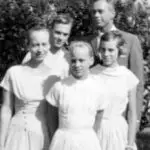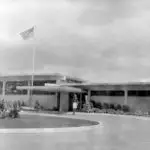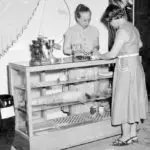James Murray Stewart
Table of Contents
Share This
Postwar Architect for Guam
If you have ever visited the Governor’s Office complex in Adelup, or attended Mass in the old Santa Teresita Church in Mangilao, or were a student at Price Elementary School, then you have seen buildings designed by architect James Murray Stewart.
From September 1948 to June 1959 Stewart (1915 – 2008) was contracted by the US Naval government, and later, by the civilian government of Guam to work as a planner and architect during the immediate postwar reconstruction of the island at the end of World War II. Stewart arrived in 1948 followed shortly afterward by his wife, Erin, and their three young children, Murray, Alice and Eliza. Both James and Erin Stewart were actively involved in the civic and social life of Guam and regularly corresponded with family back in the United States. Their letters and papers, compiled by their children decades later, provide a glimpse of the island during the reconstruction years.
Shortly after the liberation of Guam in the summer of 1944, the island was immediately placed under military control and became a staging ground for the planned invasion of Japan. Bombing and fighting to secure the island and end the Japanese occupation had resulted in extensive destruction of buildings, farmlands and coastal areas. Within a year after liberation and with money from Washington, the more than 15,000 Navy Seabees and 5,000 Army engineers built up the island with Quonset hut barracks and warehouses, three air strips, miles of new roads, an improved deep water harbor and a 2-mile breakwater.
When the war ended, villages, residences and more roads needed to be rebuilt, along with schools and other government buildings and infrastructure. Labor, skilled and unskilled, and planners needed to be brought in to assist with the reconstruction.
Employment in Guam
James Stewart was born on 15 July 1915 in Memphis, Tennessee to Porter Murray and Edna Hyatt Stewart. He married Erin Gary in 1939. Although he did not have a formal degree, Stewart studied modern architecture and was skilled at various aspects of engineering and design. He worked for the Park Commissions in Memphis and Baltimore (Maryland) as principal architectural draftsman with the Baltimore Park Engineering Department. He designed children’s zoos as part of his work and also helped restore and build homes.
According to his daughter, Alice, her father had initially been hired for Guam as a Navy civilian contractor, then with the passage of the Organic Act, as an employee of the Government of Guam. A resident of Washington, DC visiting relatives in Memphis had seen homes Stewart had designed in the Memphis Commercial Appeal, and encouraged Stewart to apply for a job to assist with the rebuilding of Guam. Stewart apparently prepared for his interview by researching and sketching out a city plan the night before. On 22 July 1948, Stewart received his appointment as Architect for the Guam Planning Commission.
In a report to the United Nations by the US Navy in 1947, the original purpose of the Guam Planning Commission was limited to the preparation of plans for rebuilding Hagåtña, but was later extended to include all the damaged villages throughout the island. Their task was to plan the “new villages, new houses and new sites necessary to make the Island a community equipped and settled in accordance with modern principles of construction, comfort, convenience and economic utility.” Further, the commission would study and plan for “communities suitably zoned for economic operation with houses and villages designed and located for maximum convenience and comfort with regard to natural resources, terrain and climatic conditions.”
The plans put forth by the commission would then be used as the “basis for public construction and made available to the native population as a guide with the minimum of coercion to insure compliance with fire prevention, sanitation and typhoon protection.” Extensive public works projects, thus, were planned to rebuild the island with all the modern American conveniences. To meet the need for skilled technical staff, the Navy contracted civilian employees to work with the commander, Civil Engineer Corps and the Government of Guam.
During the first few weeks after his arrival, Stewart described his typical work day in a letter to his mother—meals in the cafeteria, quonset huts that served as offices for the civil government, his work drawing sketches for public buildings, issuing permits and zoning orders, surveying discussions with colleagues and dinner at the club. He described Guam as “a land of anomalies and superlatives. Its scenery surpasses the best in Florida and California combined. Beautiful mountains covered with tropical plants more exotic than I had imagined.” Luxury items were plentiful, but basic necessities were not always, and often more expensive if they were. Because of the uncertainties and tensions of the Cold War happening around this time, “lights and electricity were turned off at night to save fuel.”
Erin Stewart and her three children left for Guam in July 1949. The family moved into a Quonset hut modified into a house in Mangilao, near Dairy Road and San Isidro Drive. A couple of months after their arrival, Typhoon Allyn struck, damaging their home and compounding their challenges to adjust to life on a tropical island.
Stewart’s projects
Under the Naval Government, the Planning Commission was a separate department but was subsumed under Public Works when civilian Carlton Skinner was appointed Governor of Guam under the newly implemented Organic Act. Stewart was the head of the Planning Section of the Department of Public Works, in charge of engineering and planning. In addition to studying areas for potential building sites, he was also tasked with developing schematic drawings for proposed buildings to handle “all design and decorating problems for the Government of Guam,” right down to ordering ornamental shrubbery for government buildings.
In 1952, Stewart had the title of Planning Commissioner. Around this time, though, he was considering joining a Hawai’i -based architectural firm with Guy Rothwell, the main architect designing the Guam Memorial Hospital. While he enjoyed and found his work with the Government of Guam to be interesting and varied, he was often frustrated with “untangling red tape,” which seemed to hinder the work with some of the architects.
Despite occasional setbacks, Stewart was involved in the planning of numerous Department of Public Works projects. In order to rehouse 35,000 residents displaced from the war, subdivisions were planned for Hagåtña, Hågat, Asan, Barrigada, Dededo, Piti, Sånta Rita-Sumai, Sinajana, Talo’fo’fo, Tamuning and Toto. Roads and easements, and zoning for schools, churches and parks also had to be included. With each new appointed governor, Stewart’s contract was renewed. In between his appointments, however, Stewart sometimes did work privately to earn extra money, providing drawings or architectural consultation.
His list of buildings and projects worked on or completed throughout his time in Guam was extensive and varied. A sampling is included here:
- Capuchin friary in Agana Heights—the first such friary to be built in Guam. He was lauded for his design and his consideration of the terrain and wind conditions of the site.
- Planning for several Catholic churches, including Talo’fo’fo (San Miguel), Yona (St. Francis) and Mangilao’s Santa Teresita church. The Mangilao church, with its Spanish mission design, was the closest to the Stewart residence. Stewart wrote to his wife that he had “planned this church with a narrower foundation for better proportions.” But, he also wrote to his mother that when it was built, the foundation had been enlarged, which ruined the sense of “proper proportions.” A few decades later, a newer, modern church was built adjacent to the old church.
- Guam Memorial Hospital and housing—Stewart had to work on the building of the interim and oversee the building of the permanent Guam Memorial Hospital after the advanced military hospital was transferred to the Government for civilian use. The Guam Memorial Hospital in Oka, Tamuning, was designed by a Hawai’i-based architect, Guy Rothwell. Stewart, though, designed the Government of Guam housing adjacent to the hospital, which is now Sagan Kotturan CHamoru.
- Pacific Press building (which published the Guam Daily News, the first privately owned newspaper) in 1952—according to Erin Stewart, the “Pacific Press had been operating in a Quonset hut before this building was erected according to James Stewart’s plans. The building was set to be built in 12 months, with a second floor featuring the editorial offices and the first floor for circulation, advertising and accounting offices and a job printing plant.” The Pacific Daily News is now housed at the newer, taller DNA Building, completed in 1973.
Stewart also supervised the planning of the construction of Government House, designed by prominent architect Richard Neutra. In addition, Stewart designed the Department of Agriculture’s administrative building, warehouses and a dairy barn, as well as a new pier at Malesso’ for fishing boats.
In early 1957, Stewart and Public Works leadership attended hearings with the Guam Legislature regarding the disparity in salaries for “Guamanians” and “Statesiders”—the latter receiving 25 percent more added on as “post differential” because of the cost of recruiting and higher cost of living. According to his wife, this was a difficult time and even his credentials, or lack of a degree, came into question. His contract, however, was renewed in May 1957, but his workload expanded to include work with the Department of Education to meet the increasing demand for more schools.
Throughout his employment, Stewart drew plans for the construction of schools in Agana Heights, Hågat, Barrigada, Chalan Pago, Dededo, Inalåhan, Malesso’, Mongmong, Piti, Sånta Rita-Sumai, Talo’fo’fo, Tamuning, Humåtak, and Yigo. He designed Wettengel School, Agat Junior High school (now Oceanview Middle School) , Inarajan Junior High, and Tumon Junior and Senior High (now John F. Kennedy) schools.
Stewart also designed the original 23-classroom Andersen Elementary School in 1956, which opened at the end of 1958. The school grounds covered 12 acres and had a capacity of 690 students and cost over $440,000 to build. There had been some opposition to the building of the air force school because of the potential for lost income tax for Guam if all the military commands wanted their own schools. Stewart also designed Adelup Elementary School, which eventually was renovated by Governor Ricardo J. Bordallo to become the new Governor’s complex in the 1980s.
Of the different schools he designed, though, Stewart’s favorite was Price Elementary School. Dedicated in 1957, the 12-classroom school’s simple, clean and modernly efficient design appealed strongly to him.
Civic activities
The Stewarts participated in Guam’s civic life and had a busy calendar of dinners, picnics, meetings and other social gatherings. Stewart was a director in the Rotary Club of Guam and served as president of the Wettengel Parent-Teachers Association, one of the schools he designed. Stewart also was a founding member and served as the first president of the Guam Symphony Orchestra Society (now, the Guam Symphony Society) and set out to establish and raise funds for a symphony orchestra for Guam. A premier performance by 32 members of the orchestra was held at the George Washington School auditorium on 13 December 1953.
Erin Stewart was an active member of the Guam Women’s Club and served as co-chairman of the Parks, Monuments and Museum Committee. This body was instrumental in the reopening of the Guam Museum in 1954 in the Garden House at the Plaza de España. She served on the Guam Public Library Board and the Girl Scout Council of Guam, and continued to support and volunteer with local groups and projects.
Back to the continent
James and Erin Stewart left Guam on 15 June 1959, their children having left a few days earlier. Upon their return, James Stewart was an architect for the Department of Housing and Urban Development (HUD) in Atlanta and St. Louis. He continued to design and decorate residences in St. Louis, Memphis, Atlanta and Louisiana, and retired in Memphis in 1980. Erin Stewart, who had a degree in mathematics, earned her master’s degree and worked for Goodwill Industry. She was a Compliance Officer for the Wage and Hour Division of the US Department of Labor and worked on one of the first cases for equal pay for equal work. She passed away in 1987 and her husband in 2008 at the age of 92. The couple is buried at Arlington Cemetery in Arlington, Tennessee.
For further reading
Stewart, James M. “Letters from Post World War II Reconstruction Guam and Appendices I, II, and III.” James M. Stewart Papers 1948-1959. Manuscripts & Spanish Documents Collection, University of Guam.
US Assistant Chief of Naval Operations. Report to United Nations on Guam, American Samoa and other island Possessions Administered by the Navy Department. Washington, DC: ACNO, 1946.
Vicariate Apostolic of Guam. “Capuchin Friary.” Umatuna si Yuus 7, no. 11 (1953): 1.




